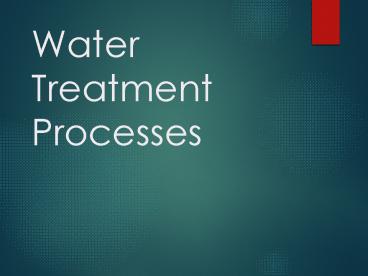Water Treatment Processes - PowerPoint PPT Presentation
1 / 15
Title:
Water Treatment Processes
Description:
Water Treatment Processes Why do we need to treat our drinking water? Industrial runoff Agricultural runoff Road runoff Residential runoff Industrial Runoff Some ... – PowerPoint PPT presentation
Number of Views:331
Avg rating:3.0/5.0
Title: Water Treatment Processes
1
Water Treatment Processes
2
Why do we need to treat our drinking water?
- Industrial runoff
- Agricultural runoff
- Road runoff
- Residential runoff
3
Industrial Runoff
- Some industrial facilities generate ordinary
domestic sewage that can run off into sewage
drains. - Industries that generate wastewater with high
concentrations of conventional pollutants (e.g.
oil and grease), toxic pollutants (e.g. heavy
metals, volatile organic compounds) or other
nonconventional pollutants such as ammonia, need
specialized treatment systems.
4
Agricultural Runoff
- Nutrients (nitrogen and phosphorus) are
typically applied to farmland as commercial
fertilizer animal manure or spraying of
municipal or industrial wastewater (effluent) or
sludge. - Nitrates and phosphates derived from these can
pose health risks to humans if they end up in the
drinking water. - Sediment (loose soil) washed off fields is the
largest source of agricultural pollution in the
United States
5
Road Runoff
- Sediments from construction sites and discharge
of toxic chemicals such as motor fuels and
concrete washout into the storm drains.
6
Residential/urban runoff
- is surface runoff of rainwater created by
urbanization. This runoff is a major source of
urban flooding and water pollution in urban
communities worldwide.
7
Water Treatment Process
http//www.youtube.com/watch?v9z14l51ISwglistPL
44OxmUx6A8pCBZRvLEg_fLf7WlWvwKodindex2
8
Step 1 Raw Water Intake and Screens
- Intake structure - delivers water to the water
treatment plant - Lake or Reservoir
- Stream or River
- Groundwater
- Screens prevent trash, logs, or fish from
entering the treatment plant
9
Step 2 Coagulation and Flocculation
- In coagulation, coagulants like lime and alum are
added to the water, which causes particulates to
clump together. - Next, the water is shaken into larger clumps,
called flocs.
10
Coagulation and Flocculation
11
Step 3 Sedimentation
- The sedimentation process requires that the water
stand for 24 hours, which allows the clumps to
settle to the bottom.
12
Settling Basin
13
Step 4 Second Filtration
- The water is then filtered,
- disinfected (usually with chlorine)
and aerated. - Aeration helps to remove certain contaminants
like radon.
14
Disinfection
- Disinfection process designed to kill or
deactivate most microorganisms in water,
including disease causing bacteria - Types of disinfection
- Physical
- Ultraviolet (UV) rays
- Heat
- Chemical
- Chlorine
- Ozone
Fecal Coliforms
Giardia lamblia
15
Storage and Distribution
- Storage keeping water for later use
- Elevated tanks
- Ground storage tanks
- Distribution system network of pipes and pump
stations that transports finished water from the
treatment plant to the user































